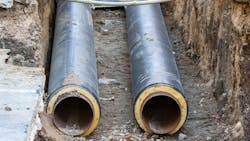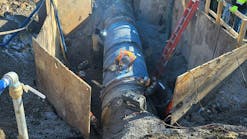Italian utility employs award-winning satellite radar solution to monitor subsidence
Like many utility companies that manage water and sewage infrastructure, Hera, one of Italy’s largest multi-utility providers, constantly monitors subtle ground movement on its 3,852 miles of pipeline. Subsidence “doesn’t need to be dramatic to be destructive and costly,” said a Hera spokesperson. “Ground motion of even a few centimeters around buried pipelines can cause leaks in the pipes, and not just water and sewer pipes — gas, electricity, and telecommunications can all be affected. These leaks can then accelerate the erosion around the critical area, damaging service and possibly creating larger problems.”
Among those larger potential problems are instability in road structures and surrounding buildings. While Hera uses sophisticated equipment like smart meters and traffic monitoring systems to address ground movement and subsidence problems, its approach was reactive, responding to citizens’ calls reporting issues after they had already occurred. The reality is that subtle ground movement is difficult to detect in advance, even by trained inspectors.
To address subsidence issues and close the technical gap within its existing systems, Hera needed a solution to monitor and detect ground movement across its network. In Rheticus, the Italian multi-utility found a way to use satellite radar data to conduct real-time surface monitoring, reduce manpower for inspections, and minimize maintenance costs.
Using Satellite Radar Data to Improve Operations
Created through a partnership between Hexagon Geospatial and Planetek Italia, Rheticus is a cloud-based service that uses satellite radar data processing to provide accurate, up-to-date information about ground instability and displacements in a pipeline network to give the utility advance warnings of possible problems. It then issues alerts to aid in prioritizing inspection and maintenance activities, increasing efficiency and lowering total management costs.
Hera, which values sustainability and the efficient application of resources, was particularly enthusiastic about the automated capabilities of Rheticus. “While it makes use of sophisticated algorithms and techniques, these are all done behind the scenes so we can focus on the answers and not the mechanics,” a Hera spokesperson said.
The mechanics, which measure and analyze ground displacement to the millimeter, provide Hera with “a kind of time machine. If something [that should] be still and stable instead moves, we can see when this started, and the trend in ground motion in the weeks after.” This information, plus historical data of work orders from sewage system failures, data on daily traffic flows, and data on the progress of the hypodermic aquifer, has been consolidated into Rheticus’ single dashboard, allowing Hera to detect problems earlier and schedule field inspections accordingly.
Because Rheticus is dynamic, constantly updating as new data comes in, Hera can make decisions with confidence. The tool is also flexible, allowing it to be customized with integrated machine learning algorithms into a sequence of processes that launch automatically. These algorithms learn by analyzing a range of data, from ground motion information and pipeline status inspections to open data sources such as pluviometers, bus routes, and GPS tracks. The result is more reliable and useful data, which means more problems and issues can be solved before they become catastrophes.
This aligns exactly with Hera’s goals. As the utility continues to improve, its future-focused efforts are concentrated on leveraging data modeling to highlight where pipeline problems are most likely to occur. The next phase of that work involves analyzing the results of field checks for correlations with satellite monitoring data. Integrating and processing the data with a machine learning approach will further optimize the system with even better maintenance outcomes as the objective.
Reducing Inspection and Maintenance Costs
Using technology like Rheticus is a good idea not only from a quality-of-life perspective but also from a financial standpoint — it’s a smart investment. According to a study by the European Association of Remote Sensing Companies (EARSC), European utility companies generally spend between €2,500 and €5,000 per kilometer for repairs. Performing focused maintenance before issues become critical, with the help of Rheticus, could reduce those costs. Rheticus can also cover vast expanses: Hera uses it to monitor more than 1,351 square miles of area. And because it measures ground displacement by satellite, it means no additional monitoring devices are required in the field, streamlining processes.
Better data leads to more fruitful inspections, too. Hera has seen a significant impact from the introduction of Rheticus. Out of 92 field inspections carried out, the utility detected 25 critical sections, including two with the highest possible damage class. Advance warning from Rheticus about changes detected in the earth’s surface allows Hera to act before situations deteriorate. Damage to the sewer system is effectively prevented through proactive inspection and maintenance, saving Hera both money and manpower.
By connecting satellite and operational data to trigger predictive maintenance, Hera has improved the effectiveness of its pipeline inspections by 30 percent. Problem areas can be targeted for the maximum yield of probable benefit for the hours workers put in, giving planners, schedulers, and field crews the ability to focus on other critical projects. Structures can be saved before subsidence causes any real damage.
Eliminating the threats of ruinous leakage and downtime is a goal Hera strives to achieve. Rheticus is a key component of making those plans a reality. “The availability of fresh information on ground, building, and infrastructure stability in an easy-to-use dynamic dashboard ensures timely and informed decisions on the management of our valuable infrastructure,” a Hera spokesperson said. “Instead of spending time analyzing data, we can focus on inspecting and fixing problems before they become disasters, saving money and keeping citizens safe and happy.”
Recognizing Innovation
In November 2019, the Smart City Expo World Congress took notice of Hera’s efforts. At its World Smart City Awards, Hexagon and Planetek Italia were recognized as the winner of the Urban Environment category on the strength of Rheticus and its use by Hera. The World Smart City Awards seek to recognize pioneering projects, ideas, and strategies that promote sustainable urban development around the globe.
Hera’s inventive use of Rheticus checked all those boxes, and it benefited the utility in other ways as well. The ability to proactively collect and analyze network data gave Hera the capacity to maintain the integrity and availability of utility services being delivered across its network. And that’s a win not only for the utility but for every citizen under Hera’s providence. WW




